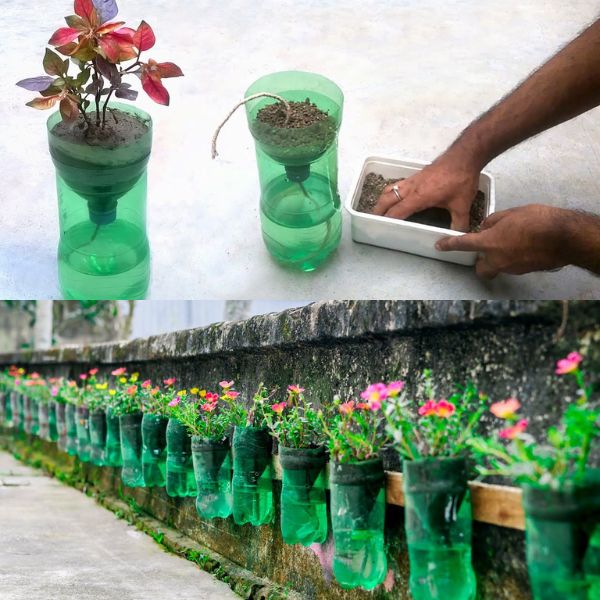When we have a garden or indoor plants, it is difficult for us to be outside for a long time. In fact, some plants like humidity and need to be watered regularly. Without watering, they can dry out and wilt, especially in hot climates. So that this question of irrigation no longer worries you, why not make self-watering pots? We tell you more in this article.
Plants need regular watering, otherwise they will wither. So that your plants never run out of water, especially your seedlings, you can make self-watering pots.
How to make a self-watering flower pot from a plastic bottle for your seedlings and plants?
Take a clean, dry plastic bottle and cut it 2/3 from the base with a sharp knife. Both bases will be used to prepare a self-watering pot.

Unscrew the cap and drill a hole in the center. Take a piece of string the same size as the bottle, fold it in half and pass it through the hole. Tie the end inside the cap and screw the cap back on. Fill the bottom of the bottle with water, then invert the top of the bottle, cap down , and insert it into the bottom. Make sure the rope is soaked in water. Fill the top of the bottle with potting soil and plant your seeds. Thanks to this trick, you will quickly get young shoots. In fact, the plastic bottle allows you to maintain heat, just like a greenhouse would do. As for the rope, it keeps the soil constantly moist. Your plants will be able to grow, without suffering drought, even if it is hot.

You can transplant your plants into the ground or into pots, as long as the seedlings reach about 10 cm in height. The season must also be suitable for planting.
In addition, the self-watering pot is not suitable for all plants. In fact, those who do not appreciate having their roots constantly wet may suffer from excess moisture. This is also the case with succulents , which have a limited need for water. In fact, these succulents have the ability to store water, thanks to their fleshy tissues. They can survive in dry and arid climates. On the other hand, plants that require frequent watering, such as geraniums and roses, will do well in a self-watering pot.
To keep your plants hydrated even when you are away, you can consider another solution: make an automatic watering system that allows drip irrigation with a plastic bottle.
How to install drip irrigation from a plastic bottle for your plants?
Take a 1.5 L plastic bottle for potted plants, or a 5 L plastic bottle for your garden or orchard plants. Unscrew the cap and drill a hole in the center. Then fill the bottle with water and replace the cap. You will just have to turn it over and push the neck towards the ground. This drip irrigation should be installed a few days before your departure. This will allow you to check the water flow and change the hole opening if necessary. Furthermore, this drip irrigation, also called microirrigation, is an economical irrigation system.
What are the tips for watering plants successfully?
When you have a garden or just green indoor plants, it is important to pay attention to the foliage of the plants. The state of the leaves allows you to know if the plant has little or much water. Too much water can be fatal for your plant. Its leaves soften and turn yellow. Additionally, the roots suffocate and rot. Not to mention that excess humidity favors attacks by insects and parasites. Hence the importance of removing stagnant water from the saucer or pot after each watering.
Under water stress, plant foliage may turn yellow. The leaves sink and may curl in on themselves, depending on the variety.

It is also advisable to adapt irrigation according to the needs of the plant and according to the seasons. Plants need less water in winter than in summer. To know if you need to water your plant, check the substrate, if it is dry to the touch, the plant needs water.
And finally, always water your plant with water at room temperature, preferably not calcareous, such as rainwater. Very cold or hot water can cause thermal shock to the plant and damage its root system.
Thanks to these simple tips, your plants will never become dehydrated!
